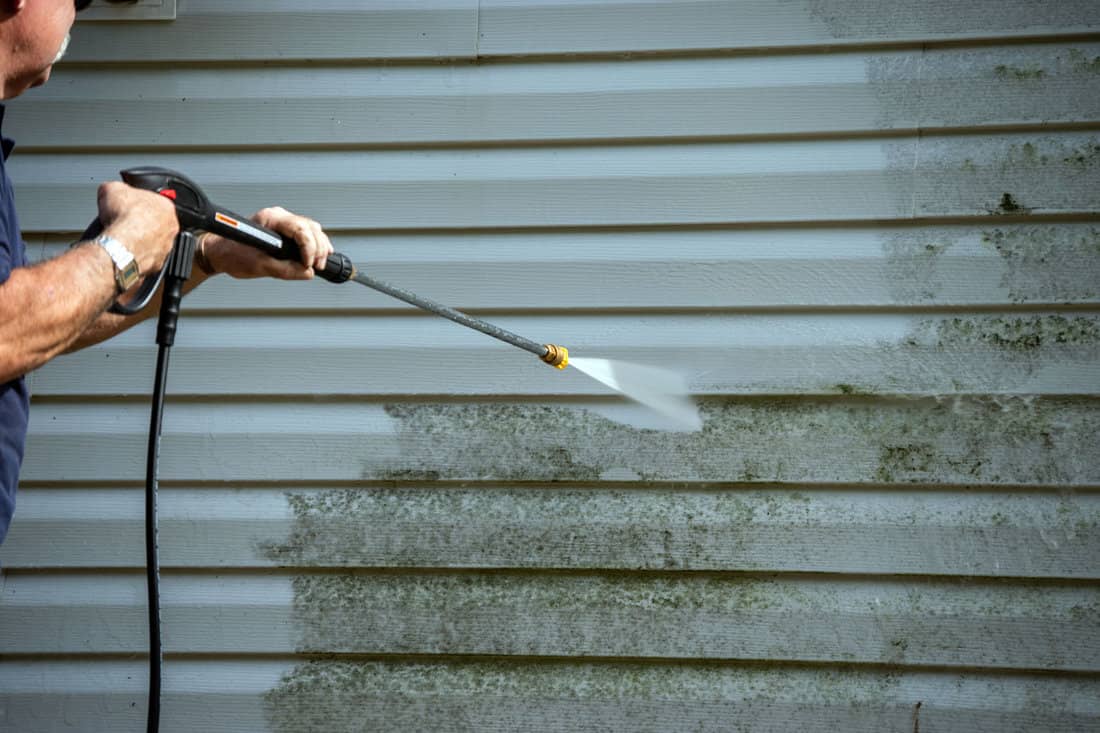When it comes to cleaning various surfaces around your home's exterior, a Ryobi pressure washer can be a game-changer.
Efficient and versatile, these pressure washers are designed to tackle various tasks such as removing dirt and grime off your driveway to washing away stubborn stains on your deck.

Before diving into your cleaning tasks, it's essential to familiarize yourself with the proper use and safety precautions of your Ryobi pressure washer.
In this article, you'll learn essential tips on how to use your Ryobi pressure washer effectively and safely.
We'll help you understand the basics such as assembling the pressure washer, adjusting the pressure settings, and knowing the different nozzle attachments.
What is a Ryobi Pressure Washer?
A Ryobi pressure washer is a powerful and versatile cleaning tool that you can use to clean various surfaces around your home.
It utilizes high-pressure water to remove dirt, grime, and stains from surfaces like decks, patios, driveways, and even vehicles.
With its user-friendly design and multiple nozzle options, you'll find it easy to tackle a wide range of cleaning tasks.
Portability
One of the key features of a Ryobi pressure washer is its portability.
Most models have robust wheels and a compact design, which will enable you to move the pressure washer around your property with ease.
Additionally, they often come with onboard storage for accessories like nozzles, hoses, and other cleaning tools, allowing you to keep everything organized and within reach.
Pressure Power
The power of your Ryobi pressure washer depends on the specific model you choose.
Typically, they offer varying pressure ratings, measured in PSI (pounds per square inch), to suit different cleaning needs.
Higher PSI ratings signify a stronger water stream, making them ideal for heavy-duty cleaning jobs, while lower PSI ratings are perfect for lighter tasks such as washing windows or rinsing off patio furniture.
Eco-Friendly
Ryobi pressure washers are also known for their efficiency and environmental friendliness.
Many models come with an auto shut-off feature that automatically powers off the motor when the trigger is not engaged, saving on energy and prolonging the life of the pressure washer.
Furthermore, they often use less water than traditional cleaning methods, making them an eco-friendly option while still delivering great results.
Parts of a Ryobi Pressure Washer
While models may vary, it's essential to familiarize yourself with the main components of your Ryobi pressure washer to use it most effectively. Here are the primary parts:
Pressure Washer Unit
This is the main body of the pressure washer, housing the engine or motor that powers the machine.
High-Pressure Hose
This durable and flexible hose delivers the high-pressure stream of water from the pressure washer unit to the spray wand.
Spray Wand and Nozzle
The nozzle at the end of the wand allows you to control the water flow and pressure. Swapping out the nozzle can change the angle or pattern of the water spray.
On/Off Switch
This switch is located on the pressure washer unit and controls the power to the machine.
Water Inlet
This is where you connect the garden hose to supply water to the pressure washer.
Soap/Detergent Tank
The onboard tank is used to store and apply cleaning detergents through the pressure washer system.
Setting Up Your Ryobi Pressure Washer
Before you begin, make sure you have all the necessary parts for your Ryobi pressure washer.
Depending on your unit model, this typically includes the pressure washer unit, trigger gun, high-pressure hose, and nozzles.
Here's the general instructions on how to set up your pressure washer:
1. Connect the Hose
First, connect the high-pressure hose to the pressure washer unit.
Locate the water inlet port on the unit, usually labeled with a water droplet icon, and attach the other end of the hose.
Make sure the connection is secure.
2. Attach Trigger Gun
Next, attach the trigger gun to the high-pressure hose. Ensure it clicks into place and is secure.
Now, select the appropriate nozzle for your cleaning task. Ryobi pressure washers often include multiple nozzles with varying spray patterns and pressure levels. Simply click the nozzle into the end of the trigger gun.
3. Connect Water Supply
Before turning on the pressure washer, connect your water supply to the unit.
Attach a garden hose to the water inlet port, making sure it's securely fastened.
Turn on the water supply to let water flow through the hose and pressure washer.
4. Safety Precautions
Now that your pressure washer is assembled, you should ensure the following safety precautions are in place:
- Do not point the pressure washer at people, animals, or any body part. The pressurized water stream could cause serious injury.
- Remain at least 12 inches away from surfaces to avoid damage.
- Be aware of your surroundings and any potential hazards.
With everything set up and safety measures in place, it's time to start your Ryobi pressure washer.
Depending on your model, you may need to push a power button or pull a starter cord. Once the pressure washer is running, squeeze the trigger gun to begin cleaning.
How to Operate Your Ryobi Pressure Washer
Using your Ryobi pressure washer can be a simple and process if you follow steps from the product manual. Remember to always prioritize safety first.
Here's a quick link to the manuals based on your Ryobi pressure washer model:
- Ryobi 2100W 2750PSi pressure washer model RACPWS4
- Ryobi 1800W 2030PSI pressure washer model RACPWS3
- Ryobi 1400W 1450PSI pressure washer model RACPWS1
If your model is not listed above, follow the general operation guidelines below on Ryobi pressure washers.
Step 1: Assemble and Connect Your Pressure Washer
Before you can start cleaning, make sure your Ryobi pressure washer is properly assembled.
Connect the pressure hose to the spray gun, and then attach the spray wand.
Insert the nozzle according to your cleaning requirements, making sure it clicks into place securely.
Step 2: Connect to a Water Supply
Attach your garden hose to the Ryobi pressure washer's water inlet.
Make sure the connection is tight, and the hose is free of any kinks or knots.
Turn on the water supply to let the water flow through the system.
Step 3: Plugin and Start the Engine
After checking that all connections are secure, plug the Ryobi pressure washer into a grounded electrical outlet.
Turn the switch on, and then press the trigger on the spray gun to release any air that may be trapped in the system.
Step 4: Adjust the Pressure Settings
Choose the appropriate pressure setting for the surface you're cleaning.
Ryobi pressure washers typically come with an adjustable nozzle that allows you to easily switch between low, medium, and high-pressure settings.
Select the setting that best suits your cleaning task.
Step 5: Begin Cleaning
Now that your Ryobi pressure washer is ready to use, hold the spray gun with both hands and aim it at the surface you want to clean.
Keep the spray nozzle at least 12 inches away from the surface to prevent damage.
Start the cleaning process by pulling the trigger on the spray gun, moving in a consistent and even pattern to clean the surface effectively.
Remember to keep a firm grip on the spray gun and maintain control of the pressure washer at all times.
Take breaks if needed, and ensure that your cleaning area remains free of any tripping hazards while using your Ryobi pressure washer.
Shutdown and Cleanup
When you’re done using your Ryobi pressure washer, a proper shutdown and cleanup can help prolong its life.
First, turn off the pressure washer by pressing the "OFF" button on the power switch.
To stop the flow of water, close the water source faucet. Then, gently squeeze the spray wand trigger to release any remaining water pressure in the system.
Detach the garden hose from the pressure washer and then carefully disconnect the high-pressure hose from the unit and spray wand.
Make sure to keep your face away from the connections to avoid any residual water pressure.
Next, it's time to clean the nozzle. Remove any dirt or debris that might have accumulated using a nozzle cleaning tool or a small wire brush.
You may use a toothpick or similar object to clear out the nozzle holes if you don't have a cleaning tool.
After cleaning the nozzle, be sure to check the water inlet filter for debris. If necessary, remove the filter and rinse it with clean water. Reassemble the filter and secure it back in place once clean.
Before storing your Ryobi pressure washer, it's essential to drain all the water from the unit.
Tilt the pressure washer to ensure any remaining water leaves the system. Additionally, allow it to dry in an open and well-ventilated area to prevent any mold or mildew build-up.
Lastly, store your Ryobi pressure washer in a cool, dry place away from direct sunlight and extreme temperatures.
Keep the hoses, wand, nozzles, and other accessories neatly organized and stored alongside the pressure washer to prevent any potential damage.
More Tips for Efficient Use
Choose the Right Nozzle
Your Ryobi pressure washer comes with multiple nozzles for different tasks. Familiarize yourself with the color-coded nozzles and their purposes.
For example, the 0-degree nozzle provides a powerful jet for intense cleaning, while the 40-degree nozzle offers a wider spray for lighter tasks.
Always start with the widest spray angle and work your way down, as needed.
We may include affiliate links and curated AI content to highlight top design styles.
Check out this Ryobi 0 degree nozzle on Amazon.
Prepare the Surface
Before using your pressure washer, sweep the area free of loose debris. This helps to prevent the high-pressure water from launching small objects that could cause damage or injuries.
Maintain a Safe Distance
To avoid damaging surfaces or hurting yourself, maintain a distance of at least 12 inches between the nozzle and the surface you're cleaning.
If you're unsure, start farther away and slowly move closer until you find the optimal distance.
Test a Small Area
Before cleaning a large surface area, test a small, inconspicuous spot to ensure the pressure washer won't damage the surface. Adjust the nozzle or pressure as necessary.
Use Appropriate Detergent
Ryobi pressure washers can use detergent to help break down tough grime.
Make sure to use a detergent appropriate for the surface you're cleaning and follow the manufacturer's instructions for dilution and application.
Work Systematically
When using your pressure washer, work in a steady, methodical manner.
Move the nozzle in consistent, overlapping strokes, working from top to bottom to prevent streaking.
Additionally, if cleaning a vertical surface, start at the top and work your way down to prevent dirty water from running over the clean areas.
Confidence in Using Your Ryobi Pressure Washer
The Ryobi pressure washer can be a powerful tool in maintaining the cleanliness of your home when used properly.
By following the right operating procedures and safety precautions, you can ensure a thorough and efficient cleaning experience.
Enjoy the benefits of a well-maintained home, and happy cleaning!
For more tips on handling Ryobi products, check out these other articles:




